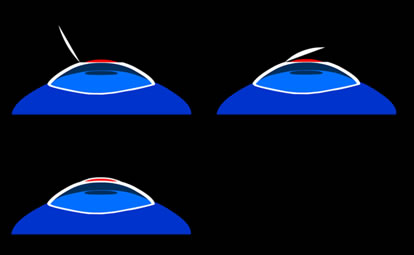| Stand
by for Implantable Contact Lenses
Martin
Drinkwater
Researchers
at the Cooperative Research Centre for Eye Research and
Technology (CRCERT) are working on a new method of vision
correction. Soon implantable contact lenses could become
a real alternative to laser eye surgery and long term
spectacle use.
As
many as one billion people worldwide suffer from some
type of vision problem. Many of these patients are seeking
permanent correction to free them from having to wear
glasses or contact lenses. Some people undergo laser eye
surgery, but this comes with strings attached. It is only
suitable for adults because it requires a ‘stable eye’.
This means that your eyeball has stopped growing and your
prescription has not changed for at least 18 months. Laser
surgery also results in loss of corneal tissue.
Researchers
at the Cooperative
Research Centre for Eye Research and Technology (CRCERT)
are working on a new method of vision correction - Implantable
contact lenses that could provide a convenient and safe
alternative to wearing glasses or having laser surgery.

Diagram
of an Implantable Contact Lens (ICL) |
A
polymer lens is surgically implanted in the cornea. This
changes the shape of the corneal surface, thereby achieving
the desired refractive correction. The cornea is responsible
for refracting light onto the back of your eye. It has
five layers: the epithelium, Bowman's membrane, stroma,
Descemet's membrane and the endothelium. The outer epithelial
layer is a protective coating, just a few cell layers
thick.

layers
of the cornea |
"Your
body naturally regenerates the epithelium if the eye is
injured," said Professor Brien Holden, Director of
CRCERT. "During the surgical procedure, we remove
the epithelium and place the implantable contact lens
directly on top of the cleaned Bowman’s membrane. The
epithelium then regrows over the contact lens."
The
synthetic lens is made from a perfluoropolyether (PFPE),
a highly porous polymer with fluorine atoms replacing
the hydrogen 'ribs' attached to the carbon 'backbone'.
During the polymerisation process, nanometre-sized pores
are formed in the lens. This allows oxygen to pass through
the lens, keeping the cornea healthy and reducing the
risk of eye infection.
"We aim to design the implantable contact lens so
that it will provide a stable refractive outcome for at
least five years," said Professor Holden. "If
a patient's prescription changes, the lens can be replaced
in a reversible surgical procedure. No permanent damage
is done to the crucial stromal tissue. If this process
is successful, people could throw away their glasses and
contact lenses!"
|